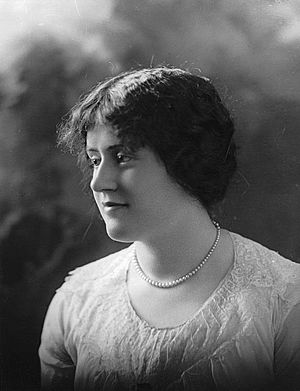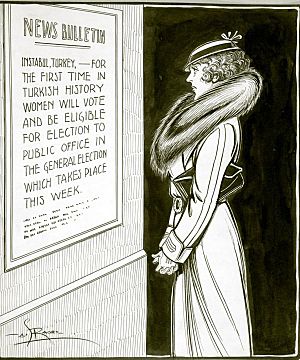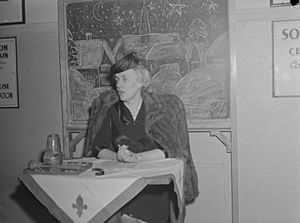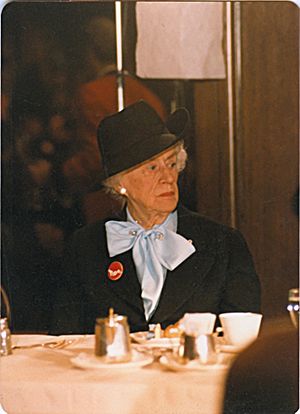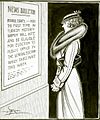Thérèse Casgrain facts for kids
Quick facts for kids
Thérèse Forget Casgrain
|
|
|---|---|

Thérèse Forget Casgrain, c. 1942
|
|
| Senator for Mille Isles, Quebec | |
| In office October 7, 1970 – July 10, 1971 |
|
| Appointed by | Pierre Trudeau |
| Preceded by | Gustave Monette |
| Succeeded by | Renaude Lapointe |
| Leader of the Parti social démocratique du Québec | |
| In office 1951–1957 |
|
| Preceded by | Romuald-Joseph Lamoureux |
| Succeeded by | Michel Chartrand |
| Personal details | |
| Born | July 10, 1896 Saint-Irénée, Quebec, Canada |
| Died | November 3, 1981 (aged 85) Montreal |
| Political party | Co-operative Commonwealth Federation (1945-1961) Parti social démocratique du Québec, New Democratic Party (1961-1970) Independent |
| Spouse | Pierre-François Casgrain (1916–1950; his death) |
| Relations | Sir Rodolphe Forget, father |
| Children | Two daughters, two sons |
Marie Thérèse Casgrain, born Forget, was a very important Canadian woman. She was a feminist and a reformer. She also became a politician and a senator. She led the fight for women's right to vote in Quebec. She was also the first woman in Canada to lead a political party. Later in her life, she worked against nuclear weapons. She also helped people as a consumer activist. She strongly believed in a united Canada. At 83, she spoke out against Quebec separating from Canada in the 1980 Quebec sovereignty referendum.
Contents
Early Life and Family
Thérèse was born on July 10, 1896, in Saint-Irénée-les-Bains, near Quebec City. She grew up in a wealthy family. Her father, Sir Rodolphe Forget, was a rich businessman and a Member of Parliament.
When she was eight, Thérèse went to a boarding school near Montreal. After finishing school, she wanted to go to university. However, her father did not think women needed more education. He believed she should learn how to manage a home instead. This was seen as important for a future wife from a good family.
In 1916, at age twenty, Thérèse married Pierre-François Casgrain. He was a wealthy politician. They had four children together. Her husband was elected to Parliament in 1917. He represented the same area her father had.
Fighting for Women's Vote
Thérèse Casgrain went to Ottawa, Canada's capital, with her husband in 1918. There, she realized how important it was for women to have the right to vote. Before 1917, women could not vote in federal elections.
In 1917, a new law allowed some women to vote. These were wives, widows, mothers, and sisters of soldiers. This was done to gain support for the war. But it was a big step for women's voting rights in Canada. By 1919, all Canadian women aged 21 or older could vote in federal elections.
Even with these changes, women in Quebec still could not vote in provincial elections. Many people, especially religious leaders and conservative groups, were against it.
Thérèse Casgrain led the women's suffrage movement in Quebec for twenty years. She was very determined. Her husband's political connections also helped her. He later became the Speaker of the House of Commons. Thérèse was a great leader and inspired many.
She started the Provincial Franchise Committee in 1921. She worked hard for women's rights. She wrote many letters to important people. She also traveled to Quebec City every year to speak about women's rights. She even had her own radio show called Fémina in the 1930s.
From 1928 to 1942, she led the League for Women's Rights. Finally, in 1938, she convinced the Liberal Party of Quebec to support women's right to vote. Women in Quebec finally won the right to vote in 1940.
A Leader in Politics
In 1941, Thérèse Casgrain's husband became a judge. She wanted to run for election in his old political area. But the Liberal Party did not choose her. So, she ran as an "Independent Liberal" but did not win.
After World War II, she left the Liberal Party. She joined the Co-operative Commonwealth Federation (CCF), a party that believed in social democracy. In 1948, she became a federal vice-president for the CCF.
From 1951 to 1957, she led the Quebec part of the CCF, called the Parti social démocratique du Québec. This made her the first woman to lead a political party in Canada. In the 1960s, she was also president of the Quebec part of the New Democratic Party, which was the CCF's new name.
Casgrain ran for federal election several times in the 1950s and 1960s. She also used her position to speak out against the government of Maurice Duplessis in Quebec.
Standing Up for Others
In 1945, Thérèse Casgrain helped women in Quebec get family allowance cheques in their own names. Before this, only fathers in Quebec received these cheques. She also pushed for married women to be treated equally in Quebec's legal system.
In the 1960s, she became an activist against nuclear weapons. In 1961, she started the Quebec branch of Voice of Women (VOW). She was the national president of VOW from 1962 to 1963. She also helped create other groups that worked for human rights and women's rights.
In 1969, Casgrain became the president of the Quebec section of the Consumers' Association of Canada. She worked to make sure the association better represented French-speaking members.
Later Years and Legacy
In 1970, Prime Minister Pierre Trudeau appointed Thérèse Casgrain to the Senate of Canada. She served as an independent senator for nine months. She had to retire at age 75, which was the mandatory retirement age. As a senator, she questioned the prime minister about Canada's use of certain chemicals in Vietnam.
In 1972, she wrote her autobiography, called A Woman in a Man's World.
In her last years, she worked to help the rights of Indigenous women. She also did charity work and continued to fight for consumer rights.
1980 Quebec Sovereignty Referendum
During the 1980 Quebec sovereignty referendum, Thérèse Casgrain campaigned for the "No" side. This meant she wanted Quebec to remain part of Canada. She was 83 years old at the time. She spoke out against a minister who suggested women who voted "No" were blocking progress.
Death
Thérèse Casgrain passed away in 1981 in Montreal. She is buried in the Cimetière Notre-Dame-des-Neiges in Montreal.
Recognition and Awards
Thérèse Casgrain received many honors for her work:
- 1967: She was made an Officer of the Order of Canada.
- 1968: She received an honorary Ph.D. from the University of Montreal.
- 1974: She was promoted to Companion of the Order of Canada, the highest level.
- 1974: Loyola College gave her the Loyola Medal.
- 1979: She was one of the first people to receive the Governor General's Award in Commemoration of the Persons Case.
- 1980: The city of Montreal gave her the title of "Grand Montrealer."
- 1980: She received another honorary doctorate from Concordia University.
- 1981: She received an honorary Ph.D. from the University of Windsor.
- 1982: The Canadian government created the Thérèse Casgrain Volunteer Award in her honor.
- 1985: Canada Post honored her with a postage stamp.
- 2004: She was featured on the $50 banknote as part of the Famous Five. This was changed in 2012.
- 2012: A statue of Casgrain and other important women was unveiled at the National Assembly of Quebec. This honored their role in Quebec politics.
- 2016: She was named commander of the Order of Montreal after her death.
Images for kids
See also
 In Spanish: Thérèse Casgrain para niños
In Spanish: Thérèse Casgrain para niños


